Hybrid Vibration Reduction System for a Vehicle Suspension under Deterministic and Random Excitations
Abstract
:1. Introduction
2. Modelling
2.1. Mathematical Model
2.2. Dynamic Similarity
2.3. Model Selection
3. Numerical Simulations
3.1. Passive Vibration Reduction System
- The M2 and M3 are similar to the M1;
- Comparison of the M4 and M5 with the M1 shows that in the assumed excitation frequency range, the sprung mass resonant frequency was mapped correctly, while the unsprung mass resonant frequency was lower than expected;
- The M5, in which the damping factor was increased compared to the M4, accurately reproduces the amplitude of the sprung mass vibrations;
- The transmissibility coefficients in the high-frequency range for the M5 do not map exactly the transmissibility coefficients for the M1.
3.2. Hybrid Suspension System
- Buffering the last 30,000 displacement samples;
- Determination function of the buffered signal;
- Calculation of the maximum value of designated by and determination of the corresponding frequency designated by .
4. Experiments
4.1. Hardware
- NI-9505 for generating shaker plate displacement and acquisition of a displacement with Sensor 1;
- NI-9505 for generating voltage realised by VR and acquisition of a displacement with Sensor 2;
- NI 9401 digital inputs and outputs for control of a potentiometer ;
- NI-9215 for displacement acquisition with Sensor 3.
4.2. Implementation Methods
4.3. Results and Discussion
5. Summary
- The method of dynamic similarity allows obtaining satisfactory accuracy in mapping the dynamics of the reference object by a scaled vibration reduction system.
- Correct reference of test results conducted for models with scaling factors , , or with respect to the reference object requires scaling both the measured output values and generated excitation.
- The random excitations allow mapping of the surface roughness for roads in class A–C and consider the scaling time and displacement factors.
- An important advantage of the described scaling method is reducing the test rig building cost. The energy saving in the research stage is significant and can be proven by considering Formulas (2) and (11). The product of is equal to so the forces generated by the LM and shaker in the test rig are about 148 less than the forces which should be generated in a full-scale model. Neglecting the restrictions in the selection of the LM and assuming , the value of should be significantly larger in a full-scale model. In addition, the value of the scaling factor shortens the time required to perform experiments.
- Regardless of the adopted scaling factors, the power saving achieved during the HVRS operation results from the amount of energy supplied to the LM. Under deterministic excitations, the LM is supplied only in a narrow frequency range (active mode), and under stochastic excitation, the value of parameter is adjusted to the road class, or the system is switched to semiactive mode with a minimal value of . According to the former study [50], the amount of energy consumed by the LM increases with the increase in the parameter value.
- The effectiveness of the HVRS is much greater than that of the PVRS, regardless of the type of excitation.
- The effectiveness of the HVRS for deterministic excitations depends on the frequency . The results of numerical simulations in the considered frequency range from to showed that the value of the coefficient (sprung mass) does not exceed and the value of the coefficient does not exceed (unsprung mass).
- The tests performed showed that the proposed algorithm for detecting the excitation signal works properly regardless of whether the displacement or the difference in displacement is used as a feedback signal.
- The assumption of a large number of buffered samples in the data preparation step introduces about a delay in excitation detection. This delay has a positive effect because it prevents the frequent switching of the , , and values.
- In the practical implementation of the HVRS, the value may be assumed by measuring the maximum instantaneous value of for the vibration reduction system with no excitation and setting to a slightly higher value. Meanwhile, the value of should also be slightly higher than the resolution value in the frequency scale used in the PSD function calculation.
Author Contributions
Funding
Data Availability Statement
Conflicts of Interest
References
- Rajamani, R. Vehicle Dynamics and Control; Springer Science & Business Media: Berlin/Heidelberg, Germany, 2011. [Google Scholar]
- Gillespie, T. Fundamentals of Vehicle Dynamics; SAE International: Warrendale, PA, USA, 2021; ISBN 978-1-4686-0177-0. [Google Scholar]
- Pauwelussen, J. Essentials of Vehicle Dynamics; Butterworth-Heinemann: Oxford, UK, 2014; ISBN 978-0-08-100058-8. [Google Scholar]
- Heidarian, A.; Wang, X. Review on Seat Suspension System Technology Development. Appl. Sci. 2019, 9, 2834. [Google Scholar] [CrossRef] [Green Version]
- Tu, L.; Ning, D.; Sun, S.; Li, W.; Huang, H.; Dong, M.; Du, H. A Novel Negative Stiffness Magnetic Spring Design for Vehicle Seat Suspension System. Mechatronics 2020, 68, 102370. [Google Scholar] [CrossRef]
- Babusiak, B.; Hajducik, A.; Medvecky, S.; Lukac, M.; Klarak, J. Design of Smart Steering Wheel for Unobtrusive Health and Drowsiness Monitoring. Sensors 2021, 21, 5285. [Google Scholar] [CrossRef]
- Kari, M.; Grosse-Puppendahl, T.; Jagaciak, A.; Bethge, D.; Schütte, R.; Holz, C. SoundsRide: Affordance-Synchronized Music Mixing for In-Car Audio Augmented Reality. In Proceedings of the 34th Annual ACM Symposium on User Interface Software and Technology, Virtual Event, 10–14 October 2021; pp. 118–133. [Google Scholar]
- Matviienko, A.; Löcken, A.; El Ali, A.; Heuten, W.; Boll, S. NaviLight: Investigating Ambient Light Displays for Turn-by-Turn Navigation in Cars. In Proceedings of the 18th International Conference on Human-Computer Interaction with Mobile Devices and Services, Florence, Italy, 6–9 September 2016; pp. 283–294. [Google Scholar]
- Gao, Z.; Wang, J.; Wang, D. Dynamic Modeling and Steering Performance Analysis of Active Front Steering System. Procedia Eng. 2011, 15, 1030–1035. [Google Scholar] [CrossRef] [Green Version]
- Reda, A.; Bouzid, A.; Vásárhelyi, J. Model Predictive Control for Automated Vehicle Steering. Acta Polytech. Hung. 2020, 17, 163–182. [Google Scholar] [CrossRef]
- Wei, C.; Wang, Y.; Asakura, Y.; Ma, L. A Nonlinear Programing Model for Collision-Free Lane-Change Trajectory Planning Based on Vehicle-to-Vehicle Communication. J. Transp. Saf. Secur. 2021, 13, 936–956. [Google Scholar] [CrossRef]
- Arcoumanis, C. Internal Combustion Engines; Elsevier: Amsterdam, The Netherlands, 2012; ISBN 978-0-323-15179-5. [Google Scholar]
- Hamid, A.F.A.; Rahman, M.T.A.; Khan, S.F.; Adom, A.H.; Rahim, M.A.; Rahim, N.A.; Ismail, M.H.N.; Norizan, A. Connected Car: Engines Diagnostic via Internet of Things (IoT). J. Phys. Conf. Ser. 2017, 908, 012079. [Google Scholar] [CrossRef]
- Benajes, J.; García, A.; Pastor, J.M.; Monsalve-Serrano, J. Effects of Piston Bowl Geometry on Reactivity Controlled Compression Ignition Heat Transfer and Combustion Losses at Different Engine Loads. Energy 2016, 98, 64–77. [Google Scholar] [CrossRef]
- Holmberg, K.; Andersson, P.; Erdemir, A. Global Energy Consumption Due to Friction in Passenger Cars. Tribol. Int. 2012, 47, 221–234. [Google Scholar] [CrossRef]
- Wu, J.; Zhang, H.; He, R.; Chen, P.; Chen, H. A Mechatronic Brake Booster for Electric Vehicles: Design, Control, and Experiment. IEEE Trans. Veh. Technol. 2020, 69, 7040–7053. [Google Scholar] [CrossRef]
- Deo, A.; Palade, V.; Huda, M.N. Centralised and Decentralised Sensor Fusion-Based Emergency Brake Assist. Sensors 2021, 21, 5422. [Google Scholar] [CrossRef] [PubMed]
- Belhocine, A.; Afzal, A. Computational Finite Element Analysis of Brake Disc Rotors Employing Different Materials. Aust. J. Mech. Eng. 2022, 20, 637–650. [Google Scholar] [CrossRef]
- Schnelle, S.; Wang, J.; Jagacinski, R.; Su, H. A Feedforward and Feedback Integrated Lateral and Longitudinal Driver Model for Personalized Advanced Driver Assistance Systems. Mechatronics 2018, 50, 177–188. [Google Scholar] [CrossRef]
- Sun, S.; Petropulu, A.P.; Poor, H.V. MIMO Radar for Advanced Driver-Assistance Systems and Autonomous Driving: Advantages and Challenges. IEEE Signal Process. Mag. 2020, 37, 98–117. [Google Scholar] [CrossRef]
- Stojanovic, N.; Abdullah, O.I.; Grujic, I.; Glisovic, J.; Belhocine, A. The Influence of Spoiler on the Aerodynamic Performances and Longitudinal Stability of the Passenger Car under High Speed Condition. J. Vis. 2022, 26, 97–112. [Google Scholar] [CrossRef]
- Aljarbouh, A.; Fayaz, M.; Qureshi, M.S.; Boujoudar, Y. Hybrid Sliding Mode Control of Full-Car Semi-Active Suspension Systems. Symmetry 2021, 13, 2442. [Google Scholar] [CrossRef]
- Krtolica, R.; Hrovat, D. Optimal Active Suspension Control Based on a Half-Car Model. In Proceedings of the 29th IEEE Conference on Decision and Control, Honolulu, HI, USA, 5–7 December 1990; 1990; Volume 4, pp. 2238–2243. [Google Scholar]
- Prabakar, R.S.; Sujatha, C.; Narayanan, S. Optimal Semi-Active Preview Control Response of a Half Car Vehicle Model with Magnetorheological Damper. J. Sound Vib. 2009, 326, 400–420. [Google Scholar] [CrossRef]
- Munawwarah, S.; Yakub, F. Control Analysis of Vehicle Ride Comfort through Integrated Control Devices on the Quarter and Half Car Active Suspension Systems. Proc. Inst. Mech. Eng. Part D J. Automob. Eng. 2021, 235, 1256–1268. [Google Scholar] [CrossRef]
- Laalej, H.; Lang, Z.Q.; Sapinski, B.; Martynowicz, P. MR Damper Based Implementation of Nonlinear Damping for a Pitch Plane Suspension System. Smart Mater. Struct. 2012, 21, 045006. [Google Scholar] [CrossRef]
- Konieczny, J.; Sibielak, M.; Rączka, W. Active Vehicle Suspension with Anti-Roll System Based on Advanced Sliding Mode Controller. Energies 2020, 13, 5560. [Google Scholar] [CrossRef]
- Naveen, A. Isuzu D-Max—Offering New Technology in The LCV Space. Auto Tech. Rev. 2014, 3, 50–51. [Google Scholar] [CrossRef]
- Lozia, Z.; Zdanowicz, P. Optimization of Damping in the Passive Automotive Suspension System with Using Two Quarter-Car Models. IOP Conf. Ser. Mater. Sci. Eng. 2016, 148, 012014. [Google Scholar] [CrossRef]
- Gobbi, M.; Levi, F.; Mastinu, G. Multi-Objective Stochastic Optimisation of the Suspension System of Road Vehicles. J. Sound Vib. 2006, 298, 1055–1072. [Google Scholar] [CrossRef]
- Negash, B.A.; You, W.; Lee, J.; Lee, C.; Lee, K. Semi-Active Control of a Nonlinear Quarter-Car Model of Hyperloop Capsule Vehicle with Skyhook and Mixed Skyhook-Acceleration Driven Damper Controller. Adv. Mech. Eng. 2021, 13, 168781402199952. [Google Scholar] [CrossRef]
- Skotnikov, G.I.; Jileykin, M.M.; Komissarov, A.I. Increasing the Stability of the Articulated Lorry at Braking by Locking the Fifth Wheel Coupling. IOP Conf. Ser. Mater. Sci. Eng. 2018, 315, 012027. [Google Scholar] [CrossRef] [Green Version]
- Snamina, J.; Orkisz, P. Energy Harvesting from Vibrations of a Two-Degree-of-Freedom Mechanical System. Acta Phys. Pol. A 2014, 125. [Google Scholar] [CrossRef]
- Kashem, S.; Nagarajah, R.; Ektesabi, M. (Eds.) Vehicle Suspension System. In Vehicle Suspension Systems and Electromagnetic Dampers; Springer Tracts in Mechanical Engineering; Springer: Singapore, 2018; pp. 23–37. ISBN 978-981-10-5478-5. [Google Scholar]
- Strecker, Z.; Mazůrek, I.; Roupec, J.; Klapka, M. Influence of MR Damper Response Time on Semiactive Suspension Control Efficiency. Meccanica 2015, 50, 1949–1959. [Google Scholar] [CrossRef]
- Ho, C.; Lang, Z.Q.; Sapiński, B.; Billings, S.A. Vibration Isolation Using Nonlinear Damping Implemented by a Feedback-Controlled MR Damper. Smart Mater. Struct. 2013, 22, 105010. [Google Scholar] [CrossRef]
- Koch, G.; Kloiber, T. Driving State Adaptive Control of an Active Vehicle Suspension System. IEEE Trans. Contr. Syst. Technol. 2014, 22, 44–57. [Google Scholar] [CrossRef]
- Gysen, B.L.J.; Paulides, J.J.H.; Janssen, J.L.G.; Lomonova, E.A. Active Electromagnetic Suspension System for Improved Vehicle Dynamics. IEEE Trans. Veh. Technol. 2010, 59, 1156–1163. [Google Scholar] [CrossRef] [Green Version]
- Orkisz, P.; Sapiński, B. Vibration Reduction System with a Linear Motor: Operation Modes, Dynamic Performance, Energy Consumption. Energies 2022, 15, 1910. [Google Scholar] [CrossRef]
- Shi, D.; Chen, L.; Wang, R.; Jiang, H.; Shen, Y. Design and Experiment Study of a Semi-Active Energy-Regenerative Suspension System. Smart Mater. Struct. 2015, 24, 015001. [Google Scholar] [CrossRef]
- Moaaz, A.O.; Ghazaly, N.M. Fuzzy and PID Controlled Active Suspension System and Passive Suspension System Comparison. Int. J. Adv. Sci. Technol. 2019, 28, 1721–1729. [Google Scholar]
- Ebrahimi, B.; Bolandhemmat, H.; Khamesee, M.B.; Golnaraghi, F. A Hybrid Electromagnetic Shock Absorber for Active Vehicle Suspension Systems. Veh. Syst. Dyn. 2011, 49, 311–332. [Google Scholar] [CrossRef]
- Patra, A.K. Backstepping LQG Controller Design for Stabilizing and Trajectory Tracking of Vehicle Suspension System. SN Appl. Sci. 2020, 2, 190. [Google Scholar] [CrossRef] [Green Version]
- Qin, W.; Shangguan, W.-B.; Xu, P.; Feng, H.; Sun, Y. A Study on Sliding Mode Control for Active Suspension System; SAE Technical Paper 2020-01-1084; SAE International: Warrendale, PA, USA, 2020. [Google Scholar]
- Li, M.; Zhang, Y.; Geng, Y. Fault-Tolerant Sliding Mode Control for Uncertain Active Suspension Systems against Simultaneous Actuator and Sensor Faults via a Novel Sliding Mode Observer. Optim. Control. Appl. Methods 2018, 39, 1728–1749. [Google Scholar] [CrossRef]
- Drehmer, L.R.C.; Paucar Casas, W.J.; Gomes, H.M. Parameters Optimisation of a Vehicle Suspension System Using a Particle Swarm Optimisation Algorithm. Veh. Syst. Dyn. 2015, 53, 449–474. [Google Scholar] [CrossRef]
- Dutta, S.; Choi, S.-M.; Choi, S.-B. A New Adaptive Sliding Mode Control for Macpherson Strut Suspension System with Magneto-Rheological Damper. J. Intell. Mater. Syst. Struct. 2016, 27, 2795–2809. [Google Scholar] [CrossRef]
- Sun, X.; Cai, Y.; Yuan, C.; Chen, L.; Wang, R. Hybrid Model Predictive Control of Damping Multi-Mode Switching Damper for Vehicle Suspensions. J. Vibroengineering 2017, 19, 2910–2930. [Google Scholar] [CrossRef] [Green Version]
- Ding, R.; Wang, R.; Meng, X.; Chen, L. Energy Consumption Sensitivity Analysis and Energy-Reduction Control of Hybrid Electromagnetic Active Suspension. Mech. Syst. Signal Process. 2019, 134, 106301. [Google Scholar] [CrossRef]
- Snamina, J.; Orkisz, P. Active Vibration Reduction System with Mass Damper Tuned Using the Sliding Mode Control Algorithm. J. Low Freq. Noise Vib. Act. Control. 2021, 40, 540–554. [Google Scholar] [CrossRef] [Green Version]
- Xie, L.; Li, J.; Cai, S.; Li, X. Electromagnetic Energy-Harvesting Damper With Multiple Independently Controlled Transducers: On-Demand Damping and Optimal Energy Regeneration. IEEE/ASME Trans. Mechatron. 2017, 22, 2705–2713. [Google Scholar] [CrossRef]
- Korzeniowski, R.; Kowal, J.; Pluta, J. Modelling, Simulations and Experimental Investigation of a Hybrid, Electrofluid Vehicle Suspension. Arch. Control. Sci. 2005, 15, 217. [Google Scholar]
- Bolster, D.; Hershberger, R.E.; Donnelly, R.J. Dynamic Similarity, the Dimensionless Science. Phys. Today 2011, 64, 42–47. [Google Scholar] [CrossRef] [Green Version]
- Sedov, L.I. Similarity, Modelling and Various Examples of the Application of Dimensional Analysis. In Similarity and Dimensional Methods in Mechanics; Elsevier: Amsterdam, The Netherlands, 1959; pp. 24–96. ISBN 978-1-4832-0088-0. [Google Scholar]
- ISO 8608:1995; Mechanical Vibration—Road Surface Profiles—Reporting of Measured Data. ISO: Geneva, Switzerland, 1995. Available online: https://www.iso.org/standard/15913.html (accessed on 17 November 2022).
- Shtessel, Y.; Edwards, C.; Fridman, L.; Levant, A. Sliding Mode Control and Observation; Springer: Berlin/Heidelberg, Germany, 2014. [Google Scholar]
- Linear Actuator, LA25-42-000A, Technical Documentation. Available online: https://www.sensata.com/sites/default/files/a/sensata-linear-actuator-LA-25-42-drawing.pdf (accessed on 17 November 2022).
- Linear Encoder with Integrated Converter, LIKA SMK, Technical Documentation. Available online: http://www.lika.pl/pliki_do_pobrania/CAT%20SMK%20E.pdf (accessed on 17 November 2022).
- Linear Encoder with Sinus/Cosinus Output, LIKA SMS12, Technical Documentation. Available online: http://www.lika.pl/pliki_do_pobrania/CAT%20SMS12%20E.pdf (accessed on 17 November 2022).
- 9063 CompactRIO Controller, Technical Documentation. Available online: https://www.ni.com/pl-pl/support/model.crio-9063.html (accessed on 17 November 2022).
- Lee, H.; Utkin, V.I. Chattering Suppression Methods in Sliding Mode Control Systems. Annu. Rev. Control. 2007, 31, 179–188. [Google Scholar] [CrossRef]
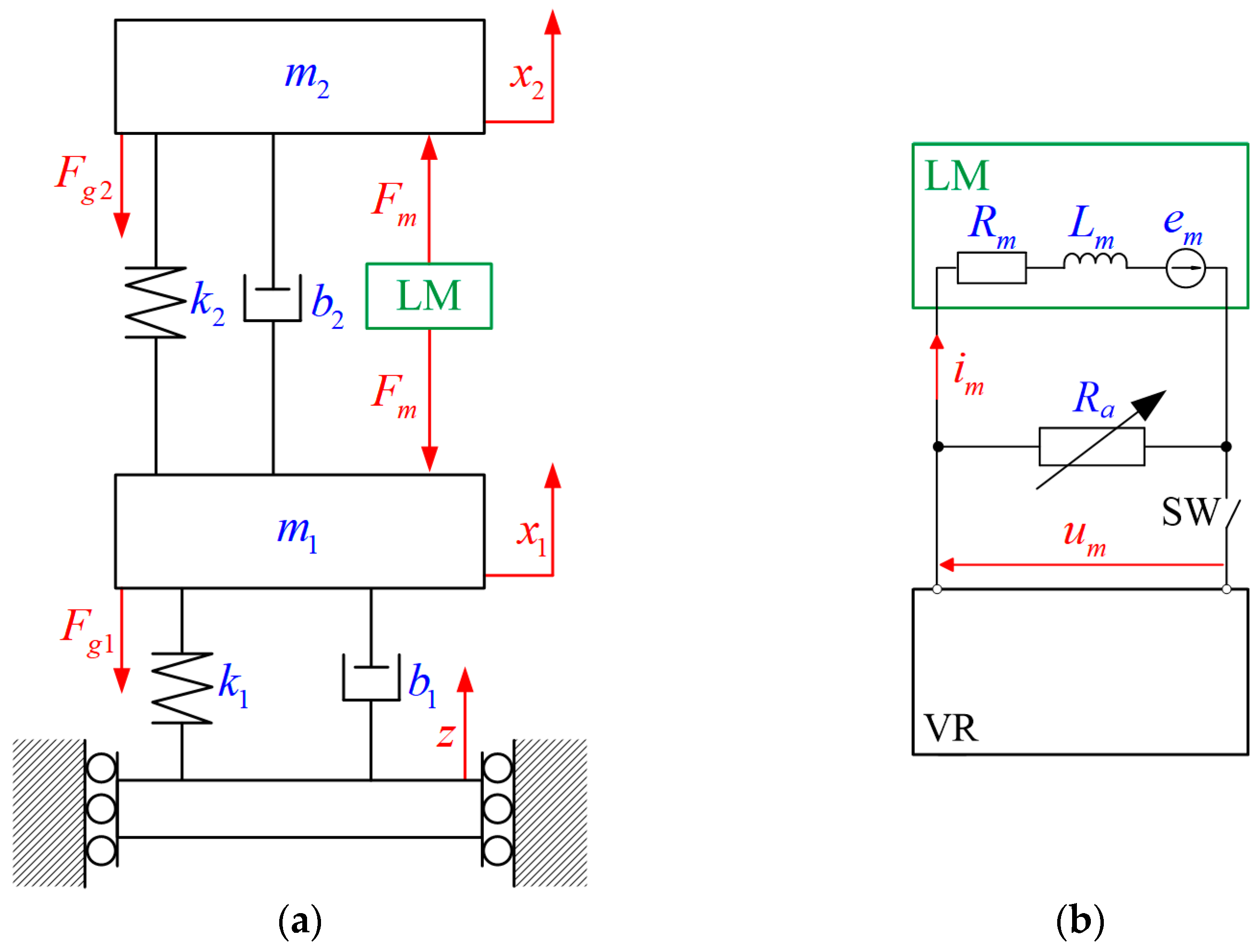
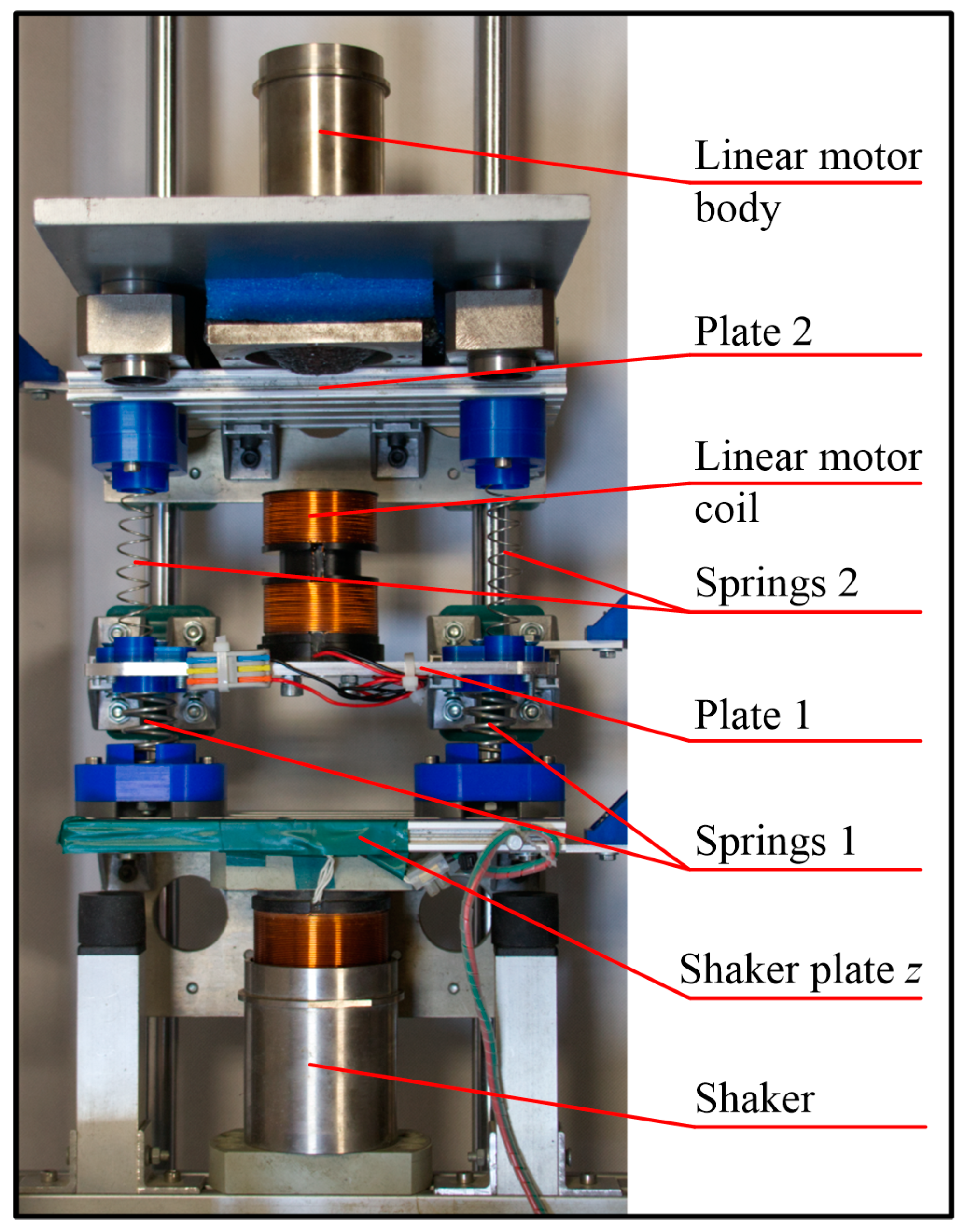

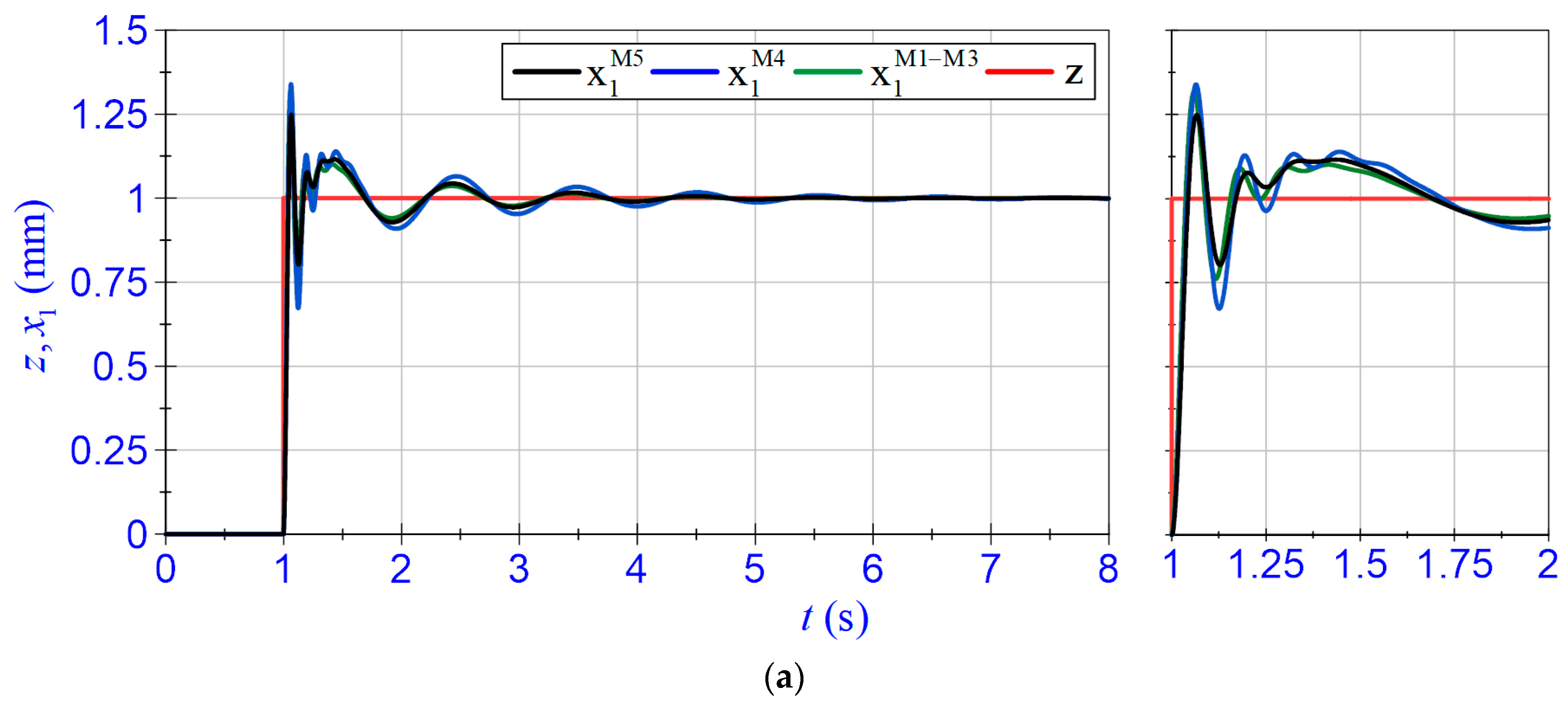
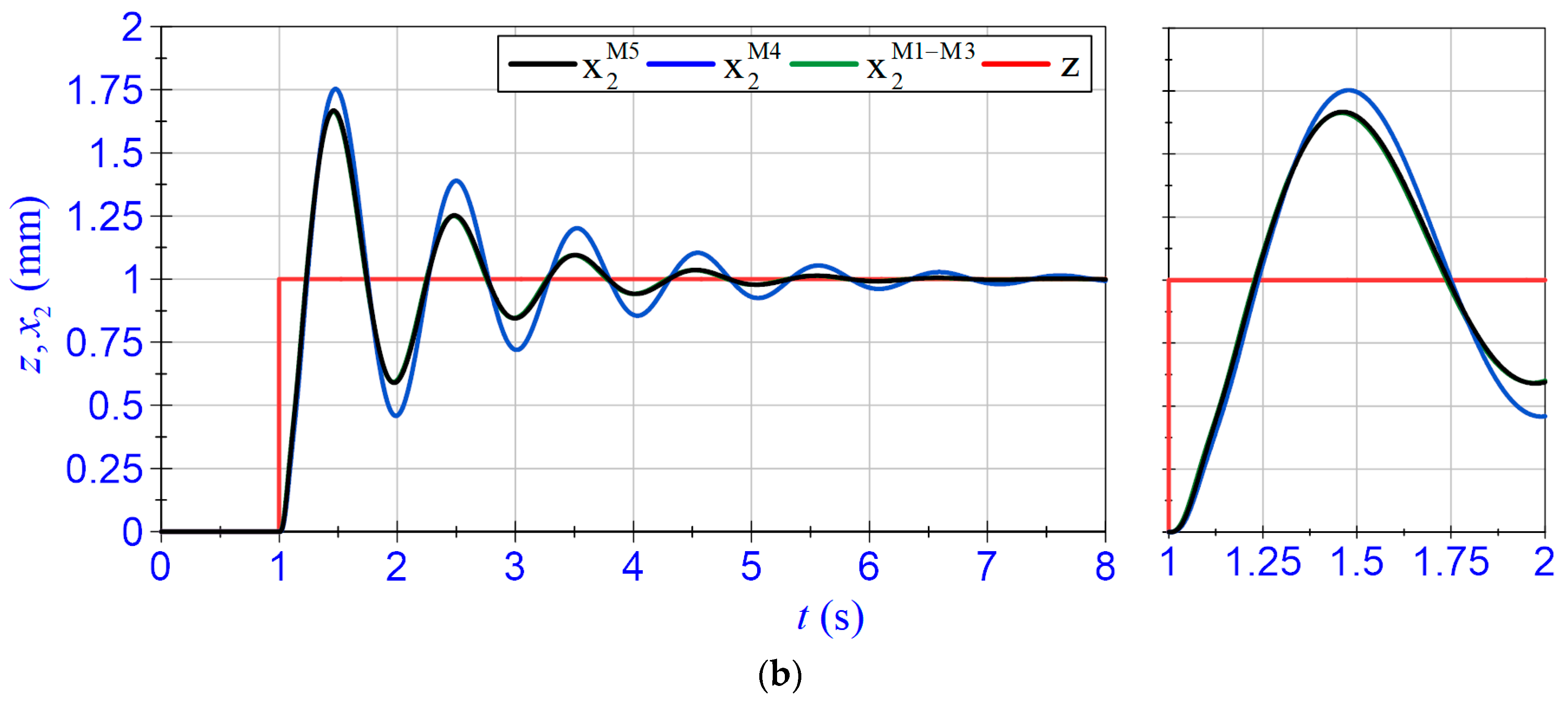
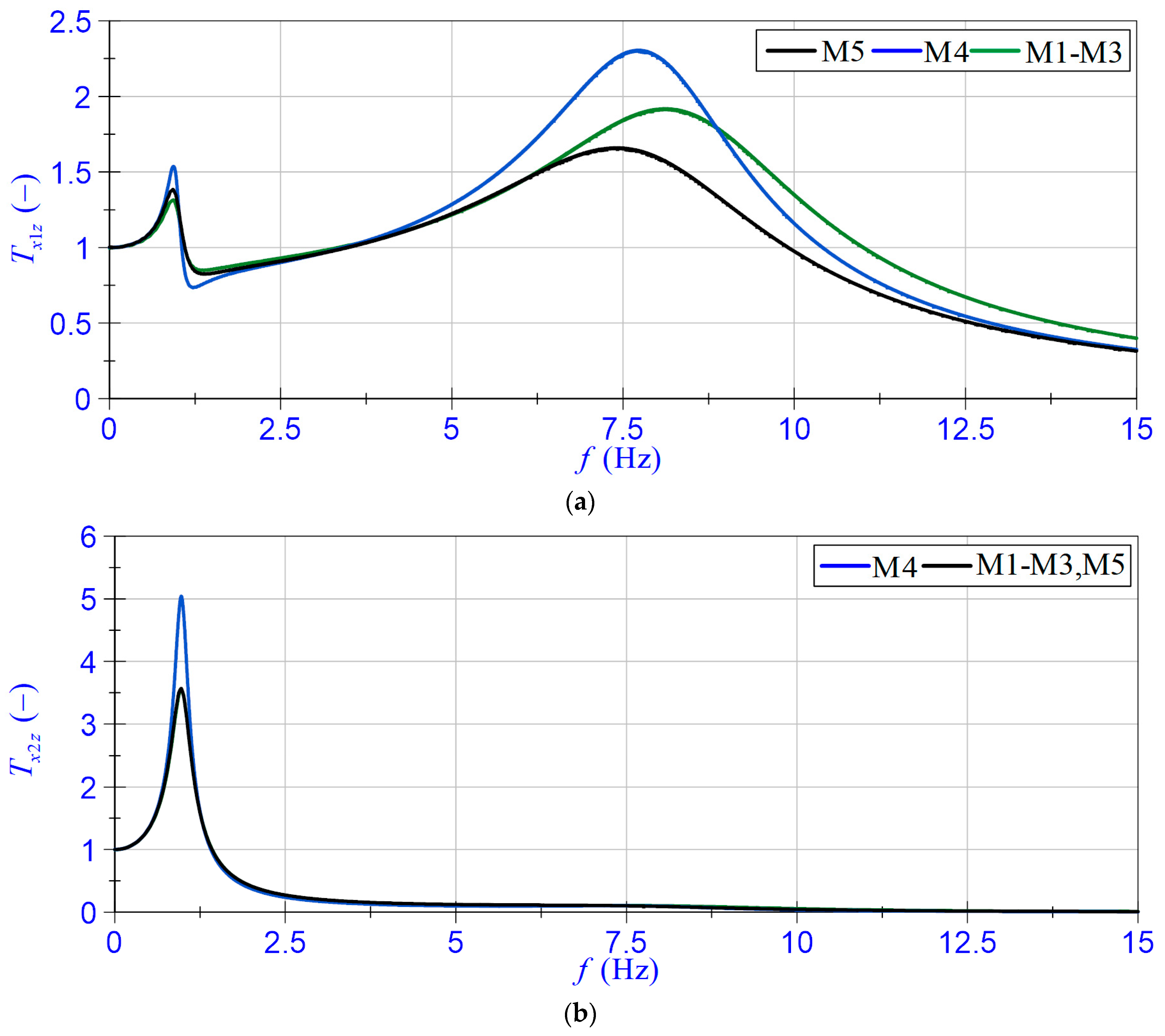
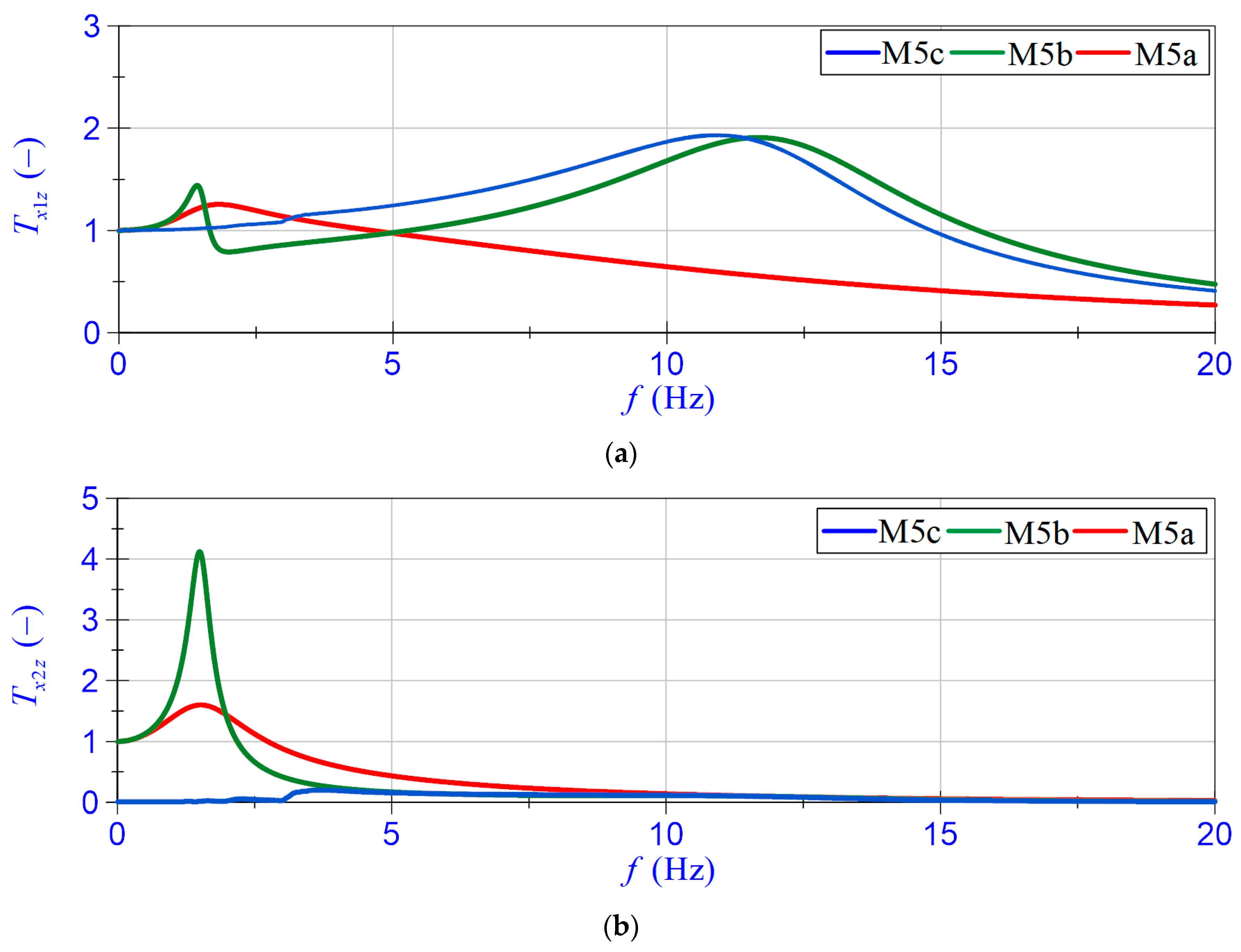
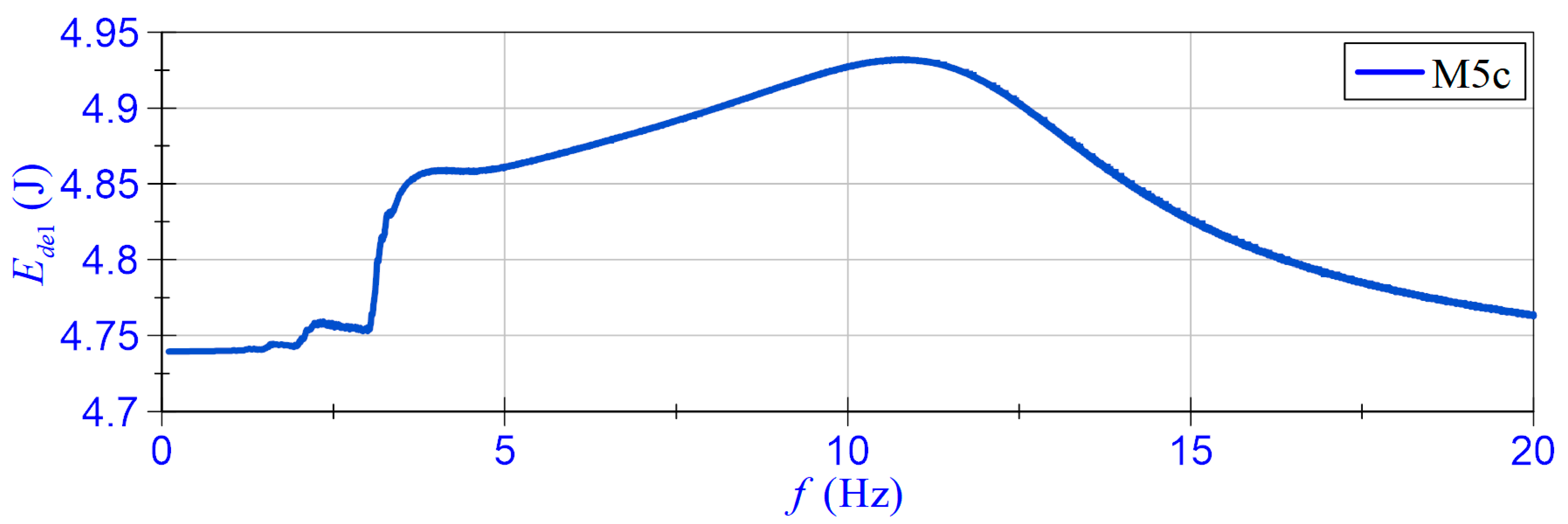
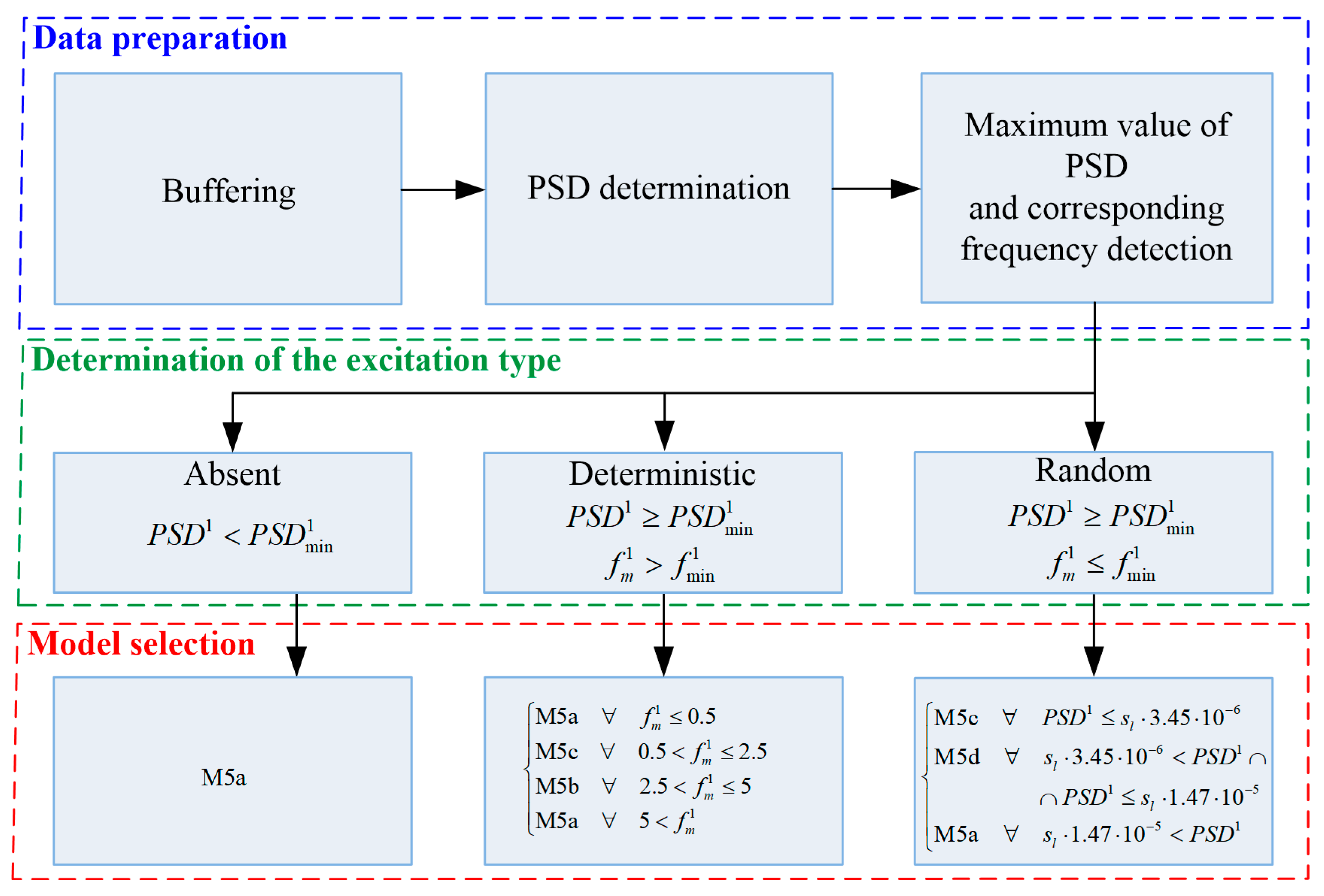



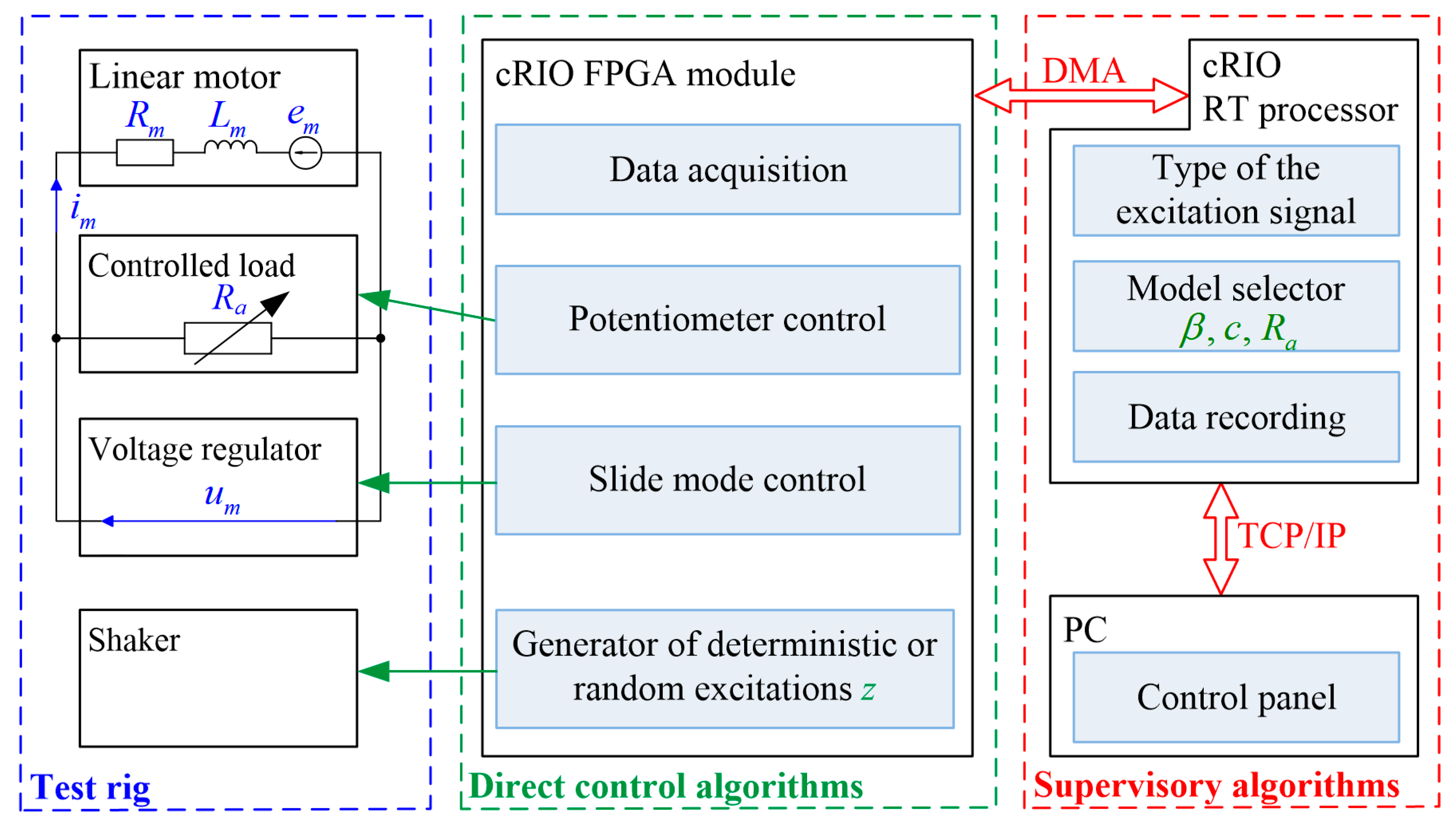

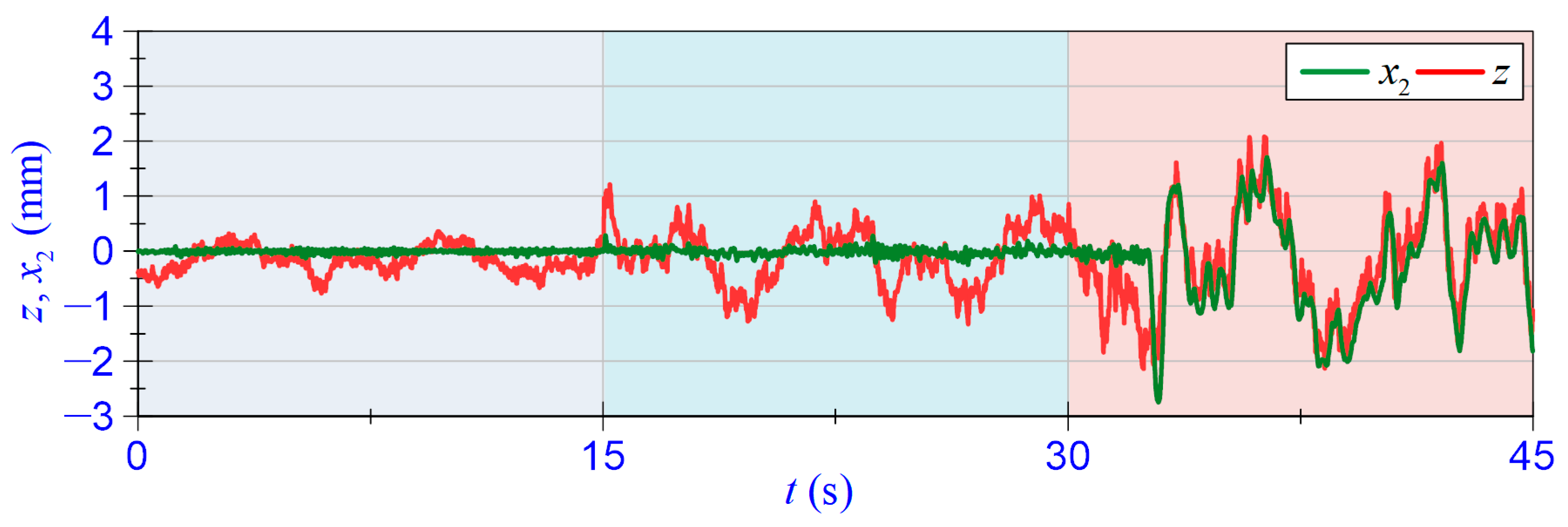
| Model | Coefficient Value | Scaling Factor |
|---|---|---|
| M1 | , , , , , | , , |
| M2 | , , , , , | , , |
| M3 | , , , , , | , , |
| Model | Coefficient Value | Electrical Parameter |
|---|---|---|
| M4 | , , , , , | - |
| M5 | , , , , , | , , , , |
| Model | |||
|---|---|---|---|
| M5a | 0 | 0 | 1 |
| M5b | 0 | 0 | 50 |
| M5c | 30 | 10 | 50 |
| M5d | 40 | 10 | 50 |
| Semiactive or Active Control Algorithm | ||||
|---|---|---|---|---|
| MS1 | 0 | 0 | 1 | |
| MS2 | 0 | 0 | 25 | |
| MA1 | 20 | 10 | 25 | |
| MA2 | 30 | 10 | 25 | |
| Hybrid control algorithm MH1 | ||||
| Type of signal | Ranges | Type of model | ||
| absent | - | MS1 | ||
| Deterministic | MS1 | |||
| MA1 | ||||
| MS2 | ||||
| MS1 | ||||
| Random | MA1 | |||
| MA2 | ||||
| MS1 | ||||
Disclaimer/Publisher’s Note: The statements, opinions and data contained in all publications are solely those of the individual author(s) and contributor(s) and not of MDPI and/or the editor(s). MDPI and/or the editor(s) disclaim responsibility for any injury to people or property resulting from any ideas, methods, instructions or products referred to in the content. |
© 2023 by the authors. Licensee MDPI, Basel, Switzerland. This article is an open access article distributed under the terms and conditions of the Creative Commons Attribution (CC BY) license (https://creativecommons.org/licenses/by/4.0/).
Share and Cite
Orkisz, P.; Sapiński, B. Hybrid Vibration Reduction System for a Vehicle Suspension under Deterministic and Random Excitations. Energies 2023, 16, 2202. https://doi.org/10.3390/en16052202
Orkisz P, Sapiński B. Hybrid Vibration Reduction System for a Vehicle Suspension under Deterministic and Random Excitations. Energies. 2023; 16(5):2202. https://doi.org/10.3390/en16052202
Chicago/Turabian StyleOrkisz, Paweł, and Bogdan Sapiński. 2023. "Hybrid Vibration Reduction System for a Vehicle Suspension under Deterministic and Random Excitations" Energies 16, no. 5: 2202. https://doi.org/10.3390/en16052202





